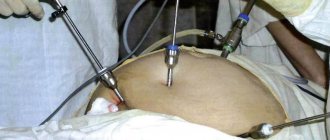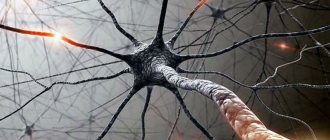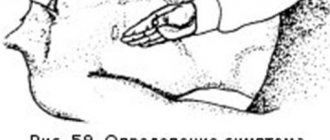The text is presented for informational purposes only. We strongly urge you not to self-medicate. When the first symptoms appear, consult a doctor. We recommend reading: “Why you can’t self-medicate?”
Shchetkin-Blumberg's symptom is one of the main signs of peritoneal irritation, determined by palpation of the abdomen. In 75% of cases, it indicates an acute surgical pathology in which surgery is necessary. This symptom was described almost simultaneously by two scientists at the beginning of the twentieth century: the German doctor Blumberg and the Russian obstetrician Shchetkin.
What is the Shchetkin-Blumberg symptom, what is it characterized by
The Shchetkin-Blumberg symptom is a preliminary diagnostic method that is based on gentle palpation of the anterior peritoneal wall. While feeling the surface of the patient's abdomen, the doctor assesses the severity of his pain.
During the examination, areas of tissue that are located in close proximity to the source of acute pain are subjected to accentuated palpation. Based on the patient’s emotional reaction, as well as his feelings, the doctor assesses the severity of the inflammatory process and the degree of tension in the spasmodic muscles. Depending on the location of the pain, a preliminary diagnosis is made, requiring instrumental confirmation.
Symptoms of appendicitis
Appendicitis can manifest itself in different ways depending on the anatomical features of the location of the appendix . It can be located in the retroperitoneum, near the liver, and even move to the pelvis during pregnancy. For this reason, no doctor can unambiguously make a diagnosis based solely on complaints of pain in the abdominal area.
The following are considered classic signs:
- pain in the epigastric region that migrates down and to the right. This is due to the pathogenesis of appendicitis and the characteristics of the innervation of the appendix;
- gradual increase in pain;
- lack of appetite;
- vomit. As a rule, with appendicitis it occurs once or twice. In this case, nausea and vomiting appear after the onset of pain;
- slight increase in temperature (up to 37-38°C);
- diarrhea or frequent and painful urge to have bowel movements;
- frequent urination;
- increased heart rate;
- occasionally there is an increase in blood pressure;
- Children with appendicitis typically experience pain during urination. This is due to the fact that an inflamed appendix irritates the bladder.
Important! If a person experiences severe abdominal pain, under no circumstances should they be given painkillers before a medical examination. Anesthesia can cause a blurred clinical picture, which, in turn, will lead to a diagnostic error that can cost the patient his life.
History of discovery
The Shchetkin-Blumberg symptom was first discovered by the German surgeon Jacob Blumberg. The technique of palpation, as well as the interpretation of the results of examination of the peritoneum, were described in detail by this physician in 1907.
Blumberg's scientific works formed the basis for diagnosing the internal organs of patients with attacks of acute pain inside the abdominal cavity. A year later, obstetrician Shchetkin, while at a meeting of the Penza Medical Society, made a statement that he used this examination technique back in the 80s of the 19th century.
Significance in diagnosis
The Shchetkin-Blumberg symptom is important for preliminary diagnosis of the abdominal cavity. Patients who are admitted to the surgical department with complaints of attacks of acute abdominal pain are examined by a doctor using this gentle palpation technique.
Shchetkin-Blumberg symptom
Using the Shchetkin-Blumberg symptom, the doctor determines the localization of the pathological process, and then refers the patient for additional examination using MRI or ultrasound diagnostics. In emergency situations, the doctor can decide on the need for surgery only based on the results of the Shchetkin-Blumberg symptom. For example, in case of detection of acute appendicitis, or perforation of an internal organ.
Result evaluation
The following options are possible:
- The symptom is positive - the moment the hand is removed, the pain in the abdomen increases sharply. Patients sometimes even scream. This reaction means irritation of the peritoneum. Possibly an acute surgical disease. The patient must be hospitalized and additional examination is carried out to clarify the diagnosis.
- The symptom is negative - when the hand is removed, the intensity of the pain does not change. There are no data on acute surgical pathology.
- A questionable result – the patient cannot clearly determine whether the pain has increased or not. The dubious symptom of Shchetkin Blumberg occurs with excess weight, ascites (accumulation of fluid in the abdominal cavity), severe tension of the abdominal muscles, as well as in the late stage of peritonitis due to the death of the nerve endings of the peritoneum.
What pathologies does the presence of a symptom mean?
The Shchetkin-Blumberg symptom is a complex of painful signs, the presence of which indicates the possible presence of the following pathologies of the abdominal cavity and neighboring parts of the body:
- acute appendicitis;
- perforation of a hollow organ with further entry of its contents into the voids of the abdominal cavity;
- peritonitis;
- pneumonia;
- myocardial infarction (the Shchetkin-Blumberg symptom is present in the initial stages of the development of a heart attack, when early diagnosis of cardiac pathology is possible);
- acute form of pancreatitis;
- hematoma in the area of the anterior wall of the peritoneum;
- uremia;
- degenerative changes in the structure of peripheral nerves responsible for the innervation of the anterior wall of the abdominal cavity;
- pseudoabdominal syndrome;
- hemorrhage in the area in the retroperitoneal tissue.
It is believed that the Shchetkin-Blumberg symptom is most pronounced in patients with peritonitis and acute appendicitis. The presence of these abdominal pathologies is easily determined by an experienced surgeon using palpation alone.
What other symptoms are there?
Several dozen symptoms have been described that indicate acute appendicitis . They are identified in a comprehensive manner: at the prehospital stage, a detailed examination helps to accurately diagnose and refer the patient for treatment to a hospital of the required profile.
The following symptoms are considered the most informative:
- Brown . The patient is asked to indicate the location of maximum pain in the supine position. After this, he is asked to lie on his left side. After 10-20 minutes, the pain intensifies or its epicenter shifts 2-3 cm downward.
- Brando . It is observed in pregnant women. If you press on the uterus on the left, the pain on the right will noticeably intensify.
- Widmera . The patient's temperature is measured first in the right and then in the left armpit. In acute appendicitis on the right it will be approximately one degree higher than on the left.
- Voskresensky (symptom of “shirt”, slipping). The clothes the patient is wearing are slightly stretched, the doctor sharply runs his hand over them in the direction from the epigastrium to the right iliac region. At the same time, the pain increases sharply.
- Dolinova . The pain becomes more intense when the patient tries to pull in his stomach.
- Rizvana . The pain becomes stronger when the patient takes a deep breath.
- Sitkovsky . When the patient lies on his left side, the pain intensifies.
We recommend: Features of diagnosing celiac disease in children and adults
This is not a complete list of symptoms used to diagnose appendicitis . Usually, the presence of one or two signs is enough for the doctor to suspect inflammation of the appendix.
Further testing is required if , for example, the Kocher and Shchetkin-Blumberg symptoms are questionable, and the clinical picture indicates acute appendicitis. This usually occurs in elderly patients, pregnant women and children, in whom the disease occurs with a blurred clinical picture, which causes frequent diagnostic errors.
How does the patient feel?
The nature of the patient’s sensations depends on the type of disease, as well as the severity of the inflammatory process. Peritonitis, appendicitis, perforation of hollow organs cause attacks of acute cutting pain, which intensifies during palpation of the anterior wall of the abdominal cavity. If a person has such sensations, the Shchetkin-Blumberg symptom is positive.
Patients with a negative test result inside the abdomen may feel discomfort but do not experience severe pain. Such symptoms persist in a calm state, as well as following gentle palpation of the muscles of the anterior abdominal wall. Extensive tissue inflammation can cause pain to spread throughout the entire peritoneum.
Further diagnostics
Patients with abdominal pain and a positive or questionable Shchetkin-Blumberg symptom are examined in a surgical hospital. The action plan depends on the preliminary diagnosis, which is made after detailed questioning and examination.
Diagnostic methods
- Complete blood count - the number of neutrophil leukocytes and ESR are sharply increased; during bleeding, hemoglobin and the number of red blood cells are reduced.
- Blood biochemistry - increased C-reactive protein, fibrinogen, sialic acids.
- General urine analysis - detects leukocytes, epithelial cells, and protein.
- Urine amylase test - amylase levels increase during acute inflammation of the pancreas.
- Ultrasound of the abdominal and pelvic organs - detects stones in the gall bladder, kidneys, cysts, abscesses, tumors, fluid in the abdominal cavity.
- Plain X-ray of the abdomen - determine the presence of gas in the abdominal cavity during perforation of the organ, fluid levels in case of intestinal obstruction.
- Diagnostic laparoscopy is a minimally invasive surgical procedure that examines the abdominal cavity from the inside using video equipment. It is carried out when it is not possible to establish a diagnosis using other methods.
- Consultation with specialists according to indications: therapist, gynecologist.
Algorithm for determining symptoms, how to palpate the abdominal cavity
The determination of the Shchetkin-Blumberg symptom is carried out in compliance with the following algorithm of actions:
- The patient takes a horizontal position, lying on his back.
- The doctor frees access to the surface of the patient's abdomen by lifting his clothes.
- The doctor applies light pressure on the anterior wall of the abdominal cavity near the source of discomfort, or directly in the area where the pathological symptoms are located.
- After squeezing the muscle tissue, the doctor sharply removes his hand from the surface of the patient’s abdomen.
In patients with the Shchetkin-Blumberg symptom, at the moment of sudden cessation of palpation, an attack of acute pain occurs as the muscles of the elastic abdominal wall contract. A similar reaction of the muscles and peripheral nerves indicates a positive diagnostic result. This outcome confirms the fact of a pathological process inside the peritoneum.
Appendicitis - symptoms and treatment
Characteristic signs of appendicitis:
1. Pain. The most important, frequent and important symptom of acute appendicitis. Most often occurs at night or early in the morning. In the first hours of the disease, it is localized in the epigastric region, that is, in the upper central part of the abdomen, under the sternum. There may also be vaguely expressed pain throughout the abdomen.
At first, the painful sensations are rarely intense, may be spastic in nature, and subside for a while. After 2-3 hours, the so-called Kocher symptom develops - displacement of pain and its localization in the right iliac region (right lower abdomen, approximately halfway between the inguinal fold and the navel).
The above-described nature of pain occurs with the typical anatomical location of the appendix.
Atypical forms and symptoms
Other options for the location of the appendix are possible: under the liver, in the pelvis, behind the cecum, retroperitoneally, and also in rare cases - in the left lower part of the abdominal cavity with situs viscerum inversus (mirror position of the internal organs). In these cases, pain can be observed respectively in the right hypochondrium, right lumbar region, above the pubis, in the right thigh, in the anus or in the left half of the abdomen. Atypical forms account for 5-8% of all cases of acute appendicitis.
There are a number of symptoms that are associated with appendicitis pain and are named after the doctors who discovered them:
- Rovsing's symptom - the appearance or intensification of pain in the right iliac region when the doctor makes jerking movements in the area of the descending colon in the left iliac region;
- Sitkovsky's symptom - the appearance or intensification of pain in the right lower abdomen if the patient lies on his left side;
- Voskresensky’s symptom (symptom of “shirt” or “sliding”) - the doctor makes a quick and light sliding movement through the shirt with his fingertips from top to bottom towards the right iliac region, while the pain intensifies at the end point of the movement;
- Obraztsov's symptom - the appearance of pain in the right iliac region when the patient raises his straightened right leg;
- Cope's symptom is the appearance of pain in the depths of the pelvis on the right and above the pubis, when the patient, while lying on his back, bends his right leg at the knee joint and turns it outward.
When a patient is admitted to the hospital, the emergency room surgeon on duty necessarily performs some of these manipulations to check for the presence of pain symptoms characteristic of appendicitis.
2. Nausea and vomiting. They do not always occur, in about 2/3 of cases. Usually, soon after the onset of initial pain, nausea appears, and then vomiting once or twice, which is rarely profuse. Vomiting is a reflex in nature; it is the result of irritation of the nerve endings of the peritoneum in the area of developing inflammation. If you do not seek help, two days after the onset of the disease, vomiting may resume, but against the background of developing peritonitis and general intoxication of the body.
3. Increased body temperature. In the first 12 hours during the initial stage of the inflammatory process, body temperature is usually 37.2-37.5 °C. In 3-7% of cases, in the first hours the temperature can reach 38 °C or more. Subsequently, after 12 hours and up to two days, the temperature usually reaches febrile levels - 38 ° C and above, a feeling of heat or chills appears.
4. Abnormal bowel movements. Uncommon, but loose stools may occur 1-3 times. Occurs when the appendix is located in the pelvis and is adjacent to the rectum or when the nerve endings of the pelvic peritoneum are irritated.
5. Frequent urination. This symptom of appendicitis is more often observed in women, which is associated either with the above-described irritation of the pelvic peritoneum, or with the effect of the inflamed appendix on the bladder or right ureter when they are close.
6. General weakness and malaise. Associated with developing intoxication of the body [2].
Why can it hurt on the other side?
In acute appendicitis, pain often occurs in other parts of the abdomen, which is associated with the spread of inflammation throughout the peritoneum. In the initial phases of the development of acute appendicitis, pain can “radiate” to the area above the pubis and to the perineum, sometimes to the right thigh. With an atypical retroperitoneal location of the appendix, pain can be localized in the right lumbar region. As the acute inflammatory process develops, the pain will spread to more and more areas.
Signs of appendicitis in women
Appendicitis in men and women occurs almost the same.
Acute appendicitis in pregnant women
During pregnancy, the location of the abdominal organs changes - they are pushed to the sides and upwards by the enlarging uterus. The cecum and appendix are also pushed upward. The incidence of acute appendicitis in pregnant and non-pregnant women of the same age is the same.
But in the case of acute appendicitis during pregnancy, the clinical picture may be uncharacteristic - the pain is localized higher, the longer the pregnancy. In addition, many pregnant women often experience nagging discomfort in the lower abdomen, in the lumbar region, nausea and vomiting. All this can lead to the fact that acute appendicitis will be detected in them in a later phase of the disease.
Surgical treatment in the first and second trimesters for uncomplicated forms is laparoscopic. In the third trimester, open interventions are more often used, since the large uterus prevents safe laparoscopy. It is very important to prevent the development of peritonitis, as this increases the likelihood of adverse consequences for the mother and fetus.
Acute appendicitis in a child
Acute appendicitis is more common in children aged 6-12 years. Perhaps this is due to the characteristics of rapid growth and physiological restructuring of the child’s body during this period. An anatomical feature of children is that the greater omentum is less developed and performs its protective function worse than in adults. Therefore, the spread of the inflammatory process throughout the abdominal cavity occurs faster.
In children, the symptoms of acute appendicitis are usually pronounced and the diagnosis is established at the first visit to a specialist.
Positive and negative result
The Shchetkin-Blumberg symptom is an attack of acute cutting pain that intensifies in response to palpation of the anterior wall of the abdominal cavity. The intensity and prevalence of discomfort depends on the type of disease that provoked the pathological state of the body.
For peritonitis
Damage to the parietal and visceral layers of the abdominal cavity leads to the spread of acute pain throughout the abdomen. With limited peritonitis, the Shchetkin-Blumberg symptom is determined only in the area of the inflammatory process.
The progression of the disease with damage to large areas of the parietal or visceral layer causes an increase in pathological signs. In case of peritonitis, the Shchetkin-Blumberg symptom is considered to be the presence of an attack of acute pain that occurs in response to palpation of the abdomen.
A negative examination result is the persistence of mild discomfort in a certain area of the abdominal cavity, or the complete absence of a negative reaction of the body in response to palpation of the abdomen.
Shchetkin-Blumberg's symptom, caused by peritonitis, is accompanied by the following additional signs:
- nausea;
- vomiting, after which the patient does not experience relief;
- hypertonicity of the muscles of the anterior peritoneal wall;
- increased pain in the abdomen during movement;
- painful sensations even with slight pressure on the surface of the anterior abdominal wall;
- fever and increased body temperature to 37-38 degrees.
Patients with signs of peritonitis need urgent medical attention. Relief of the Shchetkin-Blumberg symptom is possible only after eliminating the causes of the inflammatory process, as well as surgical sanitation of foci of necrosis.
For appendicitis
In patients with signs of appendicitis, the manifestation of the Shchetkin-Blumberg symptom always has a standard localization. During gentle palpation of the abdomen, the doctor discovers that the patient is experiencing acute pain in the iliac region on the right. Before palpating the anterior wall of the peritoneum, the patient may experience moderate discomfort, but after pressing on the tissue near the appendicitis, he experiences an attack of acute pain.
This pathology is accompanied by the following additional symptoms:
- nausea;
- loss of appetite;
- fever;
- physical weakness;
- increase in body temperature to 37 degrees.
The Shchetkin-Blumberg symptom with appendicitis may not appear immediately. The main danger of this pathology is the risk of developing extensive tissue inflammation with transition to total peritonitis.
For perforation
Violation of the integrity of the hollow organs of the abdominal cavity is one of the most severe pathologies, which poses a danger to the patient’s life. Perforation of individual sections of the gastrointestinal tract is manifested by a rich Shchetkin-Blumberg symptom. Acute pain on palpation is present in all parts of the abdomen. Even a slight touch of the doctor to the anterior wall of the peritoneum causes the patient to experience an attack of unbearable pain, which forces the latter to involuntarily draw his knees towards his body.
The Shchetkin-Blumberg symptom with perforation of the hollow organs of the abdominal cavity is manifested by the following additional signs:
- nausea;
- dizziness;
- opening of internal bleeding;
- decreased blood pressure;
- pale skin;
- vomit.
Stabilization of a patient with similar symptoms requires urgent surgery to restore the integrity of the damaged organ. The entry of gastrointestinal contents into the abdominal cavity causes the rapid development of extensive peritonitis with the risk of further death.
For uremia
The Shchetkin-Blumberg symptom, caused by uremia, has a mild manifestation. The intensity of attacks of pain inside the abdominal cavity directly depends on the severity of intoxication in the body. In patients with renal failure who do not receive adequate drug and hardware treatment, the functioning of the digestive tract organs is disrupted and pleurisy develops.
When palpating the central part of the abdominal cavity, the patient experiences acute pain, which intensifies as the body becomes intoxicated. With a negative Shchetkin-Blumberg symptom, discomfort is completely absent.
Uremia is manifested not only by the Shchetkin-Blumberg symptom, but also by the following additional signs:
- decrease in body temperature to 35 degrees;
- prostration;
- headache;
- slowness of thoughts;
- strong thirst;
- penetration of mineral salts onto the surface of the skin (precipitation of uremic frost);
- nausea;
- loss of appetite;
- vomit;
- apathy.
The Shchetkin-Blumberg symptom in uremia is considered a severe complication of chronic intoxication of the body. Lack of treatment leads to progression of pleurisy with further development of peritonitis and increased pain in the abdominal cavity.
For pneumonia
The Shchetkin-Blumberg symptom, caused by pneumonia, is manifested by moderate pain in the upper abdominal cavity. The occurrence of such a symptom is typical for patients with bilateral pneumonia with total damage to the lung tissue.
This pathology is manifested by the following additional signs:
- increase in body temperature to 38-39 degrees;
- headache;
- dry cough;
- dyspnea;
- wheezing in the bronchi;
- physical weakness;
- dizziness;
- fever.
The appearance of the Shchetkin-Blumberg symptom in patients with pneumonia may indicate the development of a severe complication in the form of pleurisy. Patients with such signs undergo mandatory diagnostic examination using radiography and MRI of the lungs.
For myocardial infarction
In patients with myocardial infarction, the Shchetkin-Blumberg symptom occurs in rare cases. A heart attack can cause severe pain in the central and left part of the chest, which spreads to the upper abdomen. The patient experiences a prolonged burning sensation. Discomfortable sensations in the abdomen are replaced by attacks of acute pain when the doctor palpates the anterior wall of the peritoneum.
The Shchetkin-Blumberg symptom, caused by myocardial infarction, is accompanied by the following additional symptoms:
- burning pain in the chest;
- dyspnea;
- cardiopalmus;
- unstable blood pressure;
- dizziness;
- severe muscle weakness;
- darkening of the eyes;
- faintness or complete loss of consciousness;
- cyanosis of the skin (this sign is especially noticeable in the area of the triangle of the nose).
Myocardial infarction, accompanied by the Shchetkin-Blumberg symptom, is dangerous and fatal. A patient with such pathological signs should be hospitalized in a cardiology department.
With hemoperitoneum
Shchetkin-Blumberg's symptom with hemoperitoneum is manifested by attacks of acute pain, which is present in all parts of the abdominal cavity. This pathology is characterized by the opening of internal bleeding with the accumulation of large volumes of blood between the parietal and visceral layers of the peritoneum. Even gentle palpation of the surface of the patient’s abdomen causes the latter to experience an attack of acute and excruciating pain.
In most cases, the appearance of the Shchetkin-Blumberg symptom with hemoperitoneum has a traumatic etiology, and is also characterized by the following additional signs:
- a sharp drop in blood pressure;
- dizziness;
- the appearance of cold sweat;
- fever;
- tachycardia;
- darkening of the eyes;
- pre-fainting state.
Clinical manifestations of this pathology and increased Shchetkin-Blumberg symptom indicate an unfavorable prognosis for the patient. In the absence of qualified surgical care, in 97% of cases, patients with hemoperitoneum die from acute blood loss and traumatic shock.
For acute pancreatitis
In patients with acute pancreatitis, the Shchetkin-Blumberg symptom is localized in the left hypochondrium and also covers the central part of the peritoneum. An attack of acute pain occurs during palpation of this area of the abdomen, and also intensifies as it approaches the inflamed tissues of the pancreas. The Shchetkin-Blumberg symptom with a negative result is a complete absence of pain, or the presence of minor discomfort.
The Shchetkin-Blumberg symptom in acute pancreatitis is manifested by the following additional signs:
- bloating;
- loss of appetite;
- girdle pain from the left hypochondrium to the left iliac region;
- nausea;
- flatulence;
- vomit;
- necrosis of inflamed pancreatic tissue;
- loss of consciousness.
Patients with Shchetkin-Blumberg's symptom, which is caused by acute pancreatitis, are immediately hospitalized in a hospital hospital. The danger of this pathology lies in the risk of necrotic damage to large areas of the pancreas.
For abdominal hematomas
With abdominal hematomas, the Shchetkin-Blumberg symptom manifests itself in the area of localization of the internal bruise. The patient feels an increase in discomfort as the doctor's fingers approach the area of the injured area of the peritoneum. With a negative Shchetkin-Blumberg sign, abdominal pain should be completely absent.
Abdominal hematomas are manifested by the following additional signs:
- swelling of the anterior peritoneal wall;
- loss of appetite;
- feeling of heaviness in the stomach;
- nausea;
- vomit;
- diarrhea.
If the tissues of internal organs are bruised, long-term health problems are possible, as well as temporary disruption of the functions of the injured parts of the body.
Major diseases
The peritoneum is a thin membrane that lines the walls and organs of the abdominal cavity from the inside. In case of inflammation, damage, or perforation of any organ, the peritoneum is also involved in the pathological process, and peritonitis develops. Due to irritation of nerve receptors, severe abdominal pain occurs, and Shchetkin’s symptom becomes positive.
- Appendicitis is the most common cause of peritonitis; infection from the altered appendix spreads to the peritoneum.
- Acute calculous cholecystitis is an inflammation of the gallbladder associated with cholelithiasis.
- Diseases of the pancreas - acute pancreatitis (inflammation), cysts and necrosis.
- Perforated ulcer of the duodenum and stomach - the formation of a through hole at the site of the ulcerative defect. The spillage of gastric or intestinal contents into the abdominal cavity leads to peritonitis.
- Pathological processes in the intestine - inflammation and perforation of colon diverticula, perforation of ulcers and tumors, acute intestinal obstruction.
- Traumatic injury - knife and gunshot wounds, closed abdominal injuries in an accident, fall, blows.
- Gynecological diseases - purulent inflammation of the fallopian tubes, rupture of an ovarian cyst, ectopic pregnancy.
- Retroperitoneal inflammatory process - with suppuration of the perinephric and pelvic tissue, the peritoneum can also be affected.
- Postoperative peritonitis - infection and mechanical damage to the peritoneum during surgery, perforation of the uterus during abortion.
- Pseudo-abdominal syndrome - abdominal pain and symptoms of peritoneal irritation not associated with pathology of the abdominal organs. More than 70 diseases causing this syndrome have been described. The most common of them are: pneumonia involving the pleura, myocardial infarction, rib fractures, diabetes mellitus, severe renal failure.
When an organ is inflamed, the Shchetkin-Blumberg symptom is determined locally, i.e. only in its projection: for example, with appendicitis - on the lower right, with cholecystitis - in the right hypochondrium. With diffuse peritonitis caused by perforation of the intestines or stomach, the entire peritoneum is affected, and the abdomen will be painful in all parts.
Questionable symptom variant
The Shchetkin-Blumberg symptom is a diagnostic technique that can have not only positive, negative outcomes, but also a dubious option. A similar examination result occurs in cases where palpation of the patient’s anterior abdominal wall does not cause severe pain, but at the same time he has a feeling of severe discomfort.
A questionable version of the Shchetkin-Blumberg symptom indicates excessive overstrain of the muscle tissue of the peritoneum, bloating, and a potential risk of developing ascites. Patients with these palpation results require additional examination to determine the causes of muscle spasm.
Confirmation of the diagnosis with a positive Shchetkin-Blumberg symptom
With a positive Shchetkin-Blumberg symptom, the patient feels acute pain in the area of inflammatory tissue damage, even with palpation of the adjacent square of the peritoneum. The presence of such signs of a pathological condition of the body requires additional examination to make a final diagnosis.
The table below describes the main methods of hardware and laboratory tests that are carried out in relation to patients with the Shchetkin-Blumberg symptom.
| Diagnostic method | Average cost and essence of the survey |
| Ultrasound | Performing an ultrasound of the abdominal cavity allows you to determine the localization of the inflammatory process, as well as examine the condition of the tissues of the internal organs that are located at the site of the pathological process. The average cost of this diagnostic is 4,400 rubles. |
| MRI | MRI is one of the most informative examination methods, which reflects the condition of the entire abdominal cavity. Using this diagnostic, the doctor detects not only foci of inflammation and injured tissue areas, but also assesses the risk of complications. The price of MRI of the abdominal cavity is 11,500 rubles. |
| Radiography | X-ray of the abdominal cavity using a contrast agent is performed in patients who have signs of injury to the hollow organs. This examination method can be used in the process of differential diagnosis. The average cost of an abdominal x-ray is 2,300 rubles. |
To assess the severity of the inflammatory process, a clinical examination of the patient’s blood and urine is prescribed. In situations where there is an objective suspicion of acute peritonitis and there is a risk of developing sepsis, the doctor prescribes the patient a microbiological blood test to isolate strains of bacterial microflora. Based on the examination results, the doctor selects an effective course of medical and surgical treatment.
The Shchetkin-Blumberg symptom is a method of preliminary diagnosis of patients who complain of discomfort or pain inside the abdominal cavity. The principle of this examination is to carefully palpate the abdomen in close proximity to the source of pathology. The doctor slowly palpates the tissues of the anterior wall of the abdominal cavity in the adjacent square from the source of pain.
The Shchetkin-Blumberg symptom is considered positive if, at the moment of relaxation of the doctor’s hand, the patient experiences acute pain at the site of the pathological process. In the absence of such sensations and mild discomfort persists, the result of palpation is considered doubtful or negative.
What is the Kocher-Volkovich sign?
The Kocher-Volkovich symptom is characteristic of acute appendicitis and is a fairly reliable diagnostic criterion indicating inflammation of the appendix.
We recommend: What is erosive duodenitis: types, symptoms and treatment methods
Kocher syndrome in acute appendicitis (symptom of pain displacement) is the phenomenon of migration of the focus of pain from the epigastric to the right iliac region .
How is it determined
The Kocher-Volkovich symptom is identified during a patient interview. When complaining of acute abdominal pain, it is important to ask how exactly the pain arose, where it radiated and how it spread.
With a positive Kocher-Volkovich symptom, the patient says that first the pain arose in the epigastric region, but after a few minutes or hours it moved to the right iliac region. Usually the migration of pain lasts 1-3 hours.
Additionally, you can ask the patient to show exactly how the pain spread . For classic acute appendicitis, he will draw a line from the xiphoid process to the right ilium.
What diseases can be diagnosed
The Kocher-Volkovich symptom is characteristic only of acute appendicitis . In other diseases accompanied by abdominal pain, it is extremely rare.
Accuracy of the method
The presence of the Kocher-Volkovich symptom almost always indicates acute appendicitis. However, its absence is not a reason to remove the diagnosis. For example, during pregnancy, the symptom may be absent, since the clinical picture of an acute abdomen becomes erased due to hormonal and physiological changes.
The symptom may be mild in children and the elderly . For this reason, after hospitalization of the patient, in all cases he is prescribed additional diagnostic examinations.









